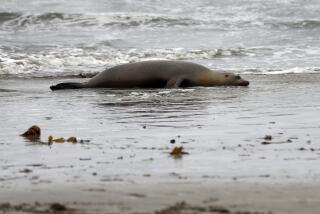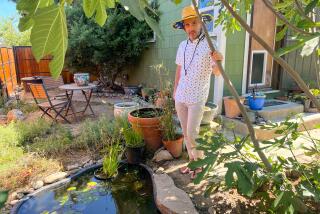Midnight Mariner
- Share via
LONG BEACH — When the cavernous Aquarium of the Pacific goes dark, Bill Maloney follows his flashlight beam to the best part of his night shift.
In a navy jumpsuit and salt-glazed work boots, he splashes through his rounds, measuring ozone and hypochlorite in 1 million gallons of salt water, mostly piped in from four miles offshore. He cleans water cleaners. He monitors monitors.
At one point, he is paged by the aquarium’s sophisticated computer.
“Woo-woo! Excitement,” he says, squinting to read his beeper, which has interrupted his test of chlorine in the sea otters’ pool. “We have a temperature alarm to check out. Must be predators. . . . The computer is smart enough to know how serious it is.”
Maloney is one of seven life-support technicians at Southern California’s newest aquarium. It’s his job to get pestered by a computer, if that’s what it takes to get 10,000 sea creatures through the night.
But his work is not all work. A marine biology graduate, Maloney, at 26, has hit the employment lotto.
While the rest of the city sleeps, he walks through the empty aquarium, his face flushed like that of a delighted 10-year-old. He fakes out the diving puffin birds by pretending to drop his keys. He pets a ray. He peers into the swell shark tank and spots a baby snout peeking out from behind a barnacle.
“Look--we got a new little one! This is so cool! This is the joy of being here.” His grin is of a sort not often observed during graveyard shifts.
And this is before he’s raced the seal.
*
As long ago as 2500 BC, the Sumerian people of southern Mesopotamia maintained fish in ponds for food. In the 1st century, the Romans turned fish into pets. The world’s first public aquarium opened in London in 1853. America got its first one three years later, in New York, sponsored by P.T. Barnum, the circus showman.
These aquariums were short-lived--as were the fish, who died for lack of proper maintenance. It was not enough just to fill a tank with water and dump creatures into it. Maintaining the habitat, from water temperature and surge to chemical balance, was and remains essential. It took about two decades for large-scale aquariums to keep sea life alive in captivity.
The nonprofit Aquarium of the Pacific is the fourth-largest public aquarium in the country these days, and even with about three football fields’ worth of exhibition space, it’s often crowded. More than 1.6 million visitors have streamed in and out since the facility opened a little less than a year ago.
So it is alluring to visit and peek behind the scenes when the place is peacefully empty--so alluring that the aquarium’s educational sleep-over program for school classes has a two-year waiting list.
“I brought my dad in,” Maloney recalls, as he arrives at 8 p.m. to start his shift, “because it’s so nice to be here like this.”
*
A blue glow bathes the Aquarium of the Pacific as Maloney’s Wednesday night shift unfolds. The neon lights go out as the hours start going by, along with the audio loops of music and other atmospherics. Before long, Maloney and another life-support tech are alone but for some custodians and security guards--and all the fishes in the deep blue fake sea.
Maloney’s shift begins in a small office with metal desks and computer terminals. The million-dollar computer took two years to set up, has no name, but runs so much of the aquarium that it triggers memories of Hal from “2001: A Space Odyssey.”
At least one of the seven techs is on duty at all times. They work four-day, 10-hour shifts because the work is hard to fit into less time. They spend about a third of their careers on the overnight shift, taking turns so that each “can have a life,” as Maloney says.
One shift passes the baton to the next. There is a nautical-looking log book and a felt-pen message board that need attention. With 17 major habitats and 30 smaller exhibits of Pacific Ocean features, and some 500 species calling them home, something almost always needs attention.
Two and a half hours of equipment checks take Maloney out behind the aquarium to aqua holding tanks, where quarantined or sick animals are watched and nursed. When animals first arrive at the aquarium, they must remain isolated for a month to assure that they can be introduced to the man-made habitat. Near the pools are huge cylinders of sand, salt water, fresh water, ozone and other materials essential to their survival.
Over a racket of rumbling and hissing, Maloney shouts out sentences dense with jargon and acronyms, then catches himself. With a sheepish smile he translates tech-talk for a visitor. The complex sand filtration and ozone injection systems, treating about 100,000 gallons of salt water every two weeks, get boiled down to: “We clean the filters that clean the water.”
As with residential plumbing, water leaves behind mineral deposits that can clog aquarium pipes, so they are closely inspected and maintained. On a good night, none of the 100 checkpoints will require tweaking; sometimes a correction, like raising the low oil level on a pump, eats up 30 minutes.
*
After Maloney uses the computer to increase water temperature at the exhibit of endangered sea turtles, it is time for a final walk-through of the various habitats. Looming darkly overhead are life-size fiberglass re-creations of an 8,375-pound blue whale, and its 450-pound calf--the biggest animal in the Pacific Ocean.
Maloney searches through a forest of swaying kelp for unwanted bubbles, which might be a sign that the system is malfunctioning. He scans the water for dead fish, finding none, as usual.
Newly arrived California king crabs, which resemble crawling macaroons, share quarters with purple urchins. Maloney and fellow tech Arthur Larcina peer into the all-glass exhibit, clearly enthralled by these latest additions. An urchin takes off a spindly crab leg before the men move on.
It’s like this for most of the patrol. When the lighting needs work in the Tropical Reef wing, Larcina peels off and Maloney continues rounds alone.
He stops to check, then admire, the dreamy moon jellies that in the water look like sheer white parachutes drifting through a turquoise sky. He knows he is lucky to have a job he loves this much.
*
Most of the life-support technicians have education or an employment background in marine biology. One used to be a tugboat pilot who towed mud barges in San Francisco Bay; another was a U.S. Fish and Game Department monitor of commercial fishing at the Long Beach port.
Maloney was 16 and needed to earn money to attend a national Boy Scout Jamboree when a high school teacher advised him of a job opening at a tropical fish store in Maloney’s Central Coast hometown of Manteca.
By the time he graduated from UC Santa Cruz, Maloney was managing the store--and had helped the owners build a 7,000-gallon saltwater system. He was making as much money as he does now, or more.
It is fortunate that his girlfriend, with whom he shares living quarters, fancies all things aquatic: At that time, the couple also shared square footage with, Maloney recalls, “three fish tanks, plus two smaller ones on a table, two more in the--oh wait, there was one in the kitchen, too. Then there was one on the dresser.”
“People would come over and laugh. The animals had more area than we had.”
When his girlfriend got a job at the Long Beach aquarium caring for the fish and working with curators, Maloney followed her south. That was a year ago in March. He started as a temp and moved a month later into his present full-time position.
There has been personal growth on the home front as well.
“We’ve now increased in gallons but decreased the number of fish tanks,” Maloney says.
Does he want to move into another job up the aquarium food chain?
“No, I’m happy with this.”
*
As he leads the way by flashlight, a prime reason swims into view. She is Shelby, a harbor seal who is one of several pinnipeds the aquarium is rehabilitating or has rehabilitated, some of them visually impaired.
Maloney starts running. “She’ll follow you back and forth,” he says. Sure enough, just inside the glass wall, she chases him from one end of the hall to the other. He stops, she stops. He cuts back, she flips into reverse.
At a tall glass porthole, they pause. Maloney winds his arm around slowly, like a clock hand. Shelby does somersaults. It’s like a scene from the old “Flipper” TV show.
Maloney watches Shelby swimming by upside down and is laughing giddily and without irony on this night shift as he says: “She is so silly. So silly.”
Nancy Wride can be reached by e-mail at [email protected].
More to Read
Sign up for The Wild
We’ll help you find the best places to hike, bike and run, as well as the perfect silent spots for meditation and yoga.
You may occasionally receive promotional content from the Los Angeles Times.






